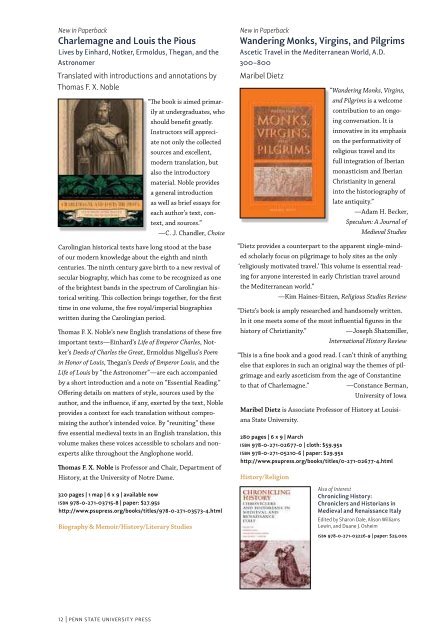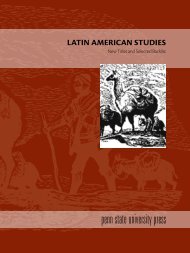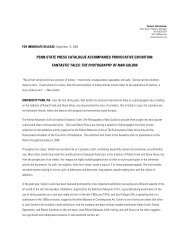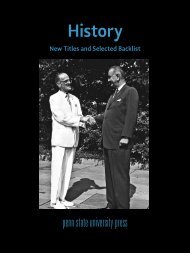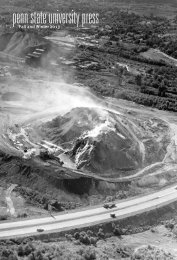journals - Pennsylvania State University Press
journals - Pennsylvania State University Press
journals - Pennsylvania State University Press
Create successful ePaper yourself
Turn your PDF publications into a flip-book with our unique Google optimized e-Paper software.
New in Paperback<br />
Charlemagne and Louis the Pious<br />
Lives by Einhard, Notker, Ermoldus, Thegan, and the<br />
Astronomer<br />
Translated with introductions and annotations by<br />
Thomas F. X. Noble<br />
“The book is aimed primarily<br />
at undergraduates, who<br />
should benefit greatly.<br />
Instructors will appreciate<br />
not only the collected<br />
sources and excellent,<br />
modern translation, but<br />
also the introductory<br />
material. Noble provides<br />
a general introduction<br />
as well as brief essays for<br />
each author’s text, context,<br />
and sources.”<br />
—C. J. Chandler, Choice<br />
Carolingian historical texts have long stood at the base<br />
of our modern knowledge about the eighth and ninth<br />
centuries. The ninth century gave birth to a new revival of<br />
secular biography, which has come to be recognized as one<br />
of the brightest bands in the spectrum of Carolingian historical<br />
writing. This collection brings together, for the first<br />
time in one volume, the five royal/imperial biographies<br />
written during the Carolingian period.<br />
Thomas F. X. Noble’s new English translations of these five<br />
important texts—Einhard’s Life of Emperor Charles, Notker’s<br />
Deeds of Charles the Great, Ermoldus Nigellus’s Poem<br />
in Honor of Louis, Thegan’s Deeds of Emperor Louis, and the<br />
Life of Louis by “the Astronomer”—are each accompanied<br />
by a short introduction and a note on “Essential Reading.”<br />
Offering details on matters of style, sources used by the<br />
author, and the influence, if any, exerted by the text, Noble<br />
provides a context for each translation without compromising<br />
the author’s intended voice. By “reuniting” these<br />
five essential medieval texts in an English translation, this<br />
volume makes these voices accessible to scholars and nonexperts<br />
alike throughout the Anglophone world.<br />
Thomas F. X. Noble is Professor and Chair, Department of<br />
History, at the <strong>University</strong> of Notre Dame.<br />
320 pages | 1 map | 6 x 9 | available now<br />
isbn 978-0-271-03715-8 | paper: $27.95s<br />
http://www.psupress.org/books/titles/978-0-271-03573-4.html<br />
Biography & Memoir/History/Literary Studies<br />
New in Paperback<br />
Wandering Monks, Virgins, and Pilgrims<br />
Ascetic Travel in the Mediterranean World, A.D.<br />
300–800<br />
Maribel Dietz<br />
“Wandering Monks, Virgins,<br />
and Pilgrims is a welcome<br />
contribution to an ongoing<br />
conversation. It is<br />
innovative in its emphasis<br />
on the performativity of<br />
religious travel and its<br />
full integration of Iberian<br />
monasticism and Iberian<br />
Christianity in general<br />
into the historiography of<br />
late antiquity.”<br />
—Adam H. Becker,<br />
Speculum: A Journal of<br />
Medieval Studies<br />
“Dietz provides a counterpart to the apparent single-minded<br />
scholarly focus on pilgrimage to holy sites as the only<br />
‘religiously motivated travel.’ This volume is essential reading<br />
for anyone interested in early Christian travel around<br />
the Mediterranean world.”<br />
—Kim Haines-Eitzen, Religious Studies Review<br />
“Dietz’s book is amply researched and handsomely written.<br />
In it one meets some of the most influential figures in the<br />
history of Christianity.” —Joseph Shatzmiller,<br />
International History Review<br />
“This is a fine book and a good read. I can’t think of anything<br />
else that explores in such an original way the themes of pilgrimage<br />
and early asceticism from the age of Constantine<br />
to that of Charlemagne.” —Constance Berman,<br />
<strong>University</strong> of Iowa<br />
Maribel Dietz is Associate Professor of History at Louisiana<br />
<strong>State</strong> <strong>University</strong>.<br />
280 pages | 6 x 9 | March<br />
isbn 978-0-271-02677-0 | cloth: $59.95s<br />
isbn 978-0-271-05210-6 | paper: $29.95s<br />
http://www.psupress.org/books/titles/0-271-02677-4.html<br />
History/Religion<br />
Also of Interest<br />
Chronicling History:<br />
Chroniclers and Historians in<br />
Medieval and Renaissance Italy<br />
Edited by Sharon Dale, Alison Williams<br />
Lewin, and Duane J. Osheim<br />
isbn 978-0-271-03226-9 | paper: $25.00s<br />
Invoking Angels<br />
Theurgic Ideas and Practices, Thirteenth to Sixteenth<br />
Centuries<br />
Edited by Claire Fanger<br />
“Invoking Angels makes an<br />
important contribution<br />
to the growing scholarly<br />
literature on medieval and<br />
early modern ritual magic.”<br />
—Christopher Lehrich,<br />
Boston <strong>University</strong><br />
Invoking Angels brings<br />
together a tightly themed<br />
collection of essays on<br />
late medieval and early<br />
modern texts concerned<br />
with the role of angels in<br />
the cosmos, focusing on<br />
angelic rituals and spiritual cosmologies. Collectively, these<br />
essays tie medieval angel magic texts more clearly to medieval<br />
religion and to the better-known author-magicians<br />
of the early modern period. In the process of rearticulating<br />
the understanding of Christian angel magic, contributors<br />
examine the places where an intersection of Christian, Jewish,<br />
and Islamic ideas can be identified.<br />
Aside from the editor, the contributors are Harvey J.<br />
Hames, Frank Klaassen, Katelyn Mesler, Sophie Page, Jan<br />
R. Veenstra, Julien Véronèse, Nicolas Weill-Parot, and<br />
Elliot R. Wolfson.<br />
Claire Fanger is Assistant Professor of Religious Studies at<br />
Rice <strong>University</strong>. She is the editor of Conjuring Spirits: Texts<br />
and Traditions of Medieval Ritual Magic (Penn <strong>State</strong>, 1998).<br />
376 pages | 5 illustrations | 6.125 x 9.25 | March<br />
isbn 978-0-271-05142-0 | cloth: $84.95s<br />
http://www.psupress.org/books/titles/978-0-271-05142-0.html<br />
Magic in History Series<br />
History/Religion<br />
Also of Interest<br />
Conjuring Spirits:<br />
Texts and Traditions of<br />
Medieval Ritual Magic<br />
Edited by Claire Fanger<br />
isbn 978-0-271-02517-9 | paper: $28.95s<br />
Magic in History Series<br />
The Italian Piazza Transformed<br />
Parma in the Communal Age<br />
Areli Marina<br />
“There is no doubt that this<br />
is a significant contribution<br />
to the field . . . an<br />
exemplary presentation<br />
of extremely complex<br />
historical processes. The<br />
scholarship is formidable.”<br />
—Charles Burroughs,<br />
Case Western<br />
Reserve <strong>University</strong><br />
During the long thirteenth<br />
century, the cities<br />
of northern Italy engendered a vital and distinctive civic<br />
culture despite constant political upheaval. In The Italian<br />
Piazza Transformed, Areli Marina examines the radical<br />
transformation of Parma’s urban center in this tumultuous<br />
period by reconstructing the city’s two most significant<br />
public spaces: its cathedral and communal squares.<br />
Treating the space of these piazzas as attentively as the<br />
buildings that shape their perimeters, she documents and<br />
discusses the evolution of each site from 1196, tracing their<br />
construction by opposing political factions within the<br />
city’s ruling elite. By the early fourteenth century, Parma’s<br />
patrons and builders had imposed strict geometric order<br />
on formerly inchoate sites, achieving a formal coherence<br />
attained by few other cities.<br />
Moreover, Marina establishes that the piazzas’ orderly<br />
contours, dramatic open spaces, and monumental buildings<br />
were more than grand backdrops to civic ritual. Parma’s<br />
squares were also agents in the production of the citystate’s<br />
mechanisms of control. They deployed brick, marble,<br />
and mortar according to both ancient Roman and contemporary<br />
courtly modes to create a physical embodiment of<br />
the modern, syncretic authority of the city’s leaders. By<br />
weaving together traditional formal and iconographic approaches<br />
with newer concepts of the symbolic, social, and<br />
political meanings of urban space, Marina reframes the<br />
complex relationship between late medieval Italy’s civic culture<br />
and the carefully crafted piazzas from which it emerged.<br />
Areli Marina is Assistant Professor of Architectural History,<br />
Art History, and Medieval Studies at the <strong>University</strong> of<br />
Illinois, Urbana-Champaign.<br />
220 pages | 102 color/7 b&w illustrations | 8 x 10 | May<br />
isbn 978-0-271-05070-6 | cloth: $84.95s<br />
http://www.psupress.org/books/titles/978-0-271-05071-3.html<br />
Architecture/History<br />
12 | penn state university press www.psupress.org | 13


